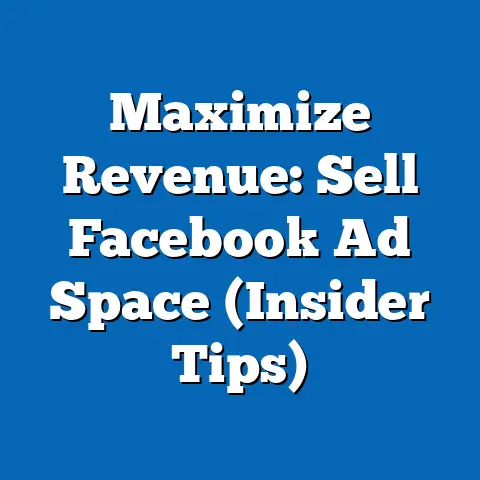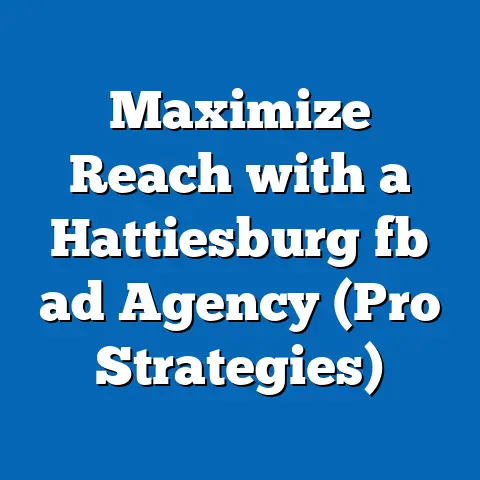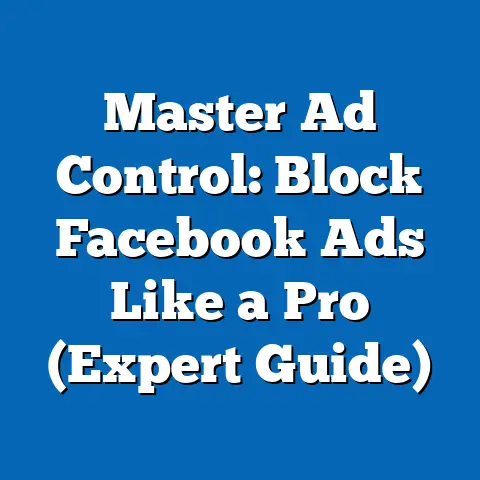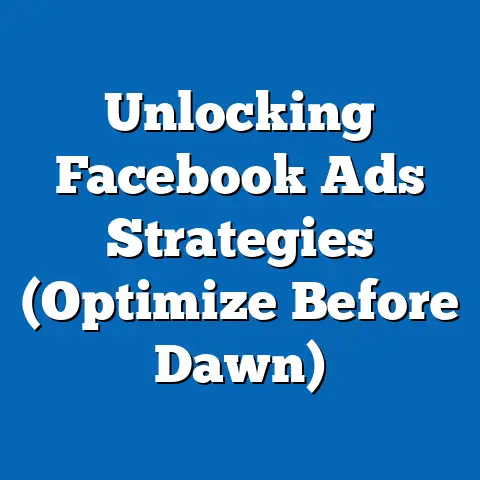Boost Sales with Facebook Ad Strategies (Game-Changer Tips)
In the realm of marketing, I’ve always found a beautiful parallel between the meticulous work of a skilled artisan and the creation of effective Facebook ad strategies. Just as a craftsman painstakingly shapes raw materials into a masterpiece, we, as marketers, must blend creativity, precision, and a deep understanding of our target audience to craft compelling messages that truly resonate. It’s never been just about throwing money at campaigns. It’s about crafting an experience, a connection, a story that captures attention in the crowded digital marketplace.
In today’s digital landscape, mastering Facebook ads is essential, but it requires more than just basic knowledge. It demands innovative strategies that can elevate sales and capture attention in a crowded digital marketplace. I’m excited to share some transformative tips that have worked wonders for me and my clients, strategies that can help you unlock the true potential of Facebook advertising and achieve remarkable results. So, let’s dive in and explore how you can boost your sales with these game-changer tips.
Understanding Your Audience
One of the most fundamental yet often overlooked aspects of successful Facebook advertising is understanding your audience. I’ve seen countless campaigns fail simply because they were targeting the wrong people. It’s like trying to sell snow to Eskimos – you might have a great product, but if there’s no demand, you’re wasting your time and resources.
Facebook’s targeting options are incredibly powerful, offering a wealth of data that can be leveraged to reach the right audience. From demographics like age, gender, and location to interests and behaviors, the platform provides a granular level of control that allows you to pinpoint your ideal customers. I often tell my clients that Facebook knows more about their customers than they do!
For instance, let’s say you’re selling organic baby food. You can target parents with young children, specifically those interested in organic products, healthy eating, and parenting-related topics. This ensures that your ads are seen by people who are most likely to be interested in your product, increasing your chances of conversion.
The Power of Customer Personas
To truly understand your audience, I highly recommend creating customer personas. These are fictional representations of your ideal customers, based on research and data about your existing and potential customers. A well-defined customer persona includes details like their age, occupation, income, interests, pain points, and motivations.
Creating customer personas allows you to step into the shoes of your target audience and understand their needs and desires. This, in turn, informs your ad creation, ensuring that your messaging resonates with them on a personal level.
For example, if you’re targeting young professionals with a busy lifestyle, your customer persona might be named “Sarah,” a 30-year-old marketing manager who values convenience and healthy options. Knowing this, you can tailor your ad copy and visuals to highlight how your product or service can simplify her life and help her achieve her goals.
Real-World Examples
I’ve worked with several businesses that have successfully tailored their ads based on thorough audience analysis. One example that stands out is a local fitness studio that was struggling to attract new clients. By conducting in-depth audience research, we discovered that their target audience was primarily women aged 25-45 who were interested in weight loss, healthy living, and group fitness classes.
Armed with this information, we created targeted Facebook ads that highlighted the studio’s unique offerings, such as personalized training programs, supportive community, and convenient class schedules. The results were remarkable – the studio saw a 50% increase in new client sign-ups within the first month of launching the targeted campaign.
Takeaway: Invest time in understanding your audience. Use Facebook’s targeting options and create customer personas to guide your ad creation. Tailor your messaging to resonate with your target audience’s specific needs and desires.
Crafting Compelling Ad Copy
Once you’ve identified your target audience, the next step is to craft compelling ad copy that captures their attention and persuades them to take action. I’ve learned that writing effective ad copy is an art form – it requires a delicate balance of creativity, clarity, and persuasion.
The key elements of effective ad copy are clarity, urgency, and emotional appeal. Your copy should be clear and concise, communicating your message in a way that is easy to understand. It should also create a sense of urgency, motivating people to take action now rather than later. And finally, it should appeal to their emotions, connecting with them on a personal level and addressing their needs and desires.
The Power of a Strong Call-to-Action
A strong call-to-action (CTA) is crucial for driving conversions. Your CTA should tell people exactly what you want them to do, whether it’s “Shop Now,” “Learn More,” “Sign Up,” or “Get a Free Quote.” It should be clear, concise, and action-oriented.
I’ve found that using strong verbs and creating a sense of urgency can significantly improve CTA performance. For example, instead of saying “Click Here,” try “Claim Your Discount Now” or “Get Started Today.”
Examples of Successful Ad Copy
To illustrate what makes ad copy stand out, let’s look at some examples from various industries:
- E-commerce: “Limited Time Offer! Get 20% Off All Orders. Shop Now and Upgrade Your Style!” (Clarity, urgency, and benefit-driven)
- Software: “Tired of Tedious Tasks? Automate Your Workflow with Our Powerful Software. Try It Free for 14 Days!” (Problem-solving and free trial)
- Local Business: “Delicious Pizza Delivered Right to Your Door! Order Online Now and Get a Free Garlic Bread!” (Convenience and incentive)
These examples share several common elements:
- Clear Value Proposition: They clearly communicate the value that the product or service offers.
- Specific Benefits: They highlight the specific benefits that customers will receive.
- Strong CTA: They include a clear and compelling call-to-action.
Takeaway: Craft compelling ad copy that is clear, urgent, and emotionally appealing. Use a strong call-to-action to drive conversions. Study successful ad copy from various industries and adapt their strategies to your own campaigns.
Utilizing Visuals and Video Content
In the visually-driven world of social media, visuals play a crucial role in capturing attention and driving engagement. I’ve found that ads with high-quality images and videos consistently outperform those with bland or generic visuals.
Your visuals should be eye-catching, relevant, and representative of your brand. They should also tell a story and evoke emotions, connecting with your audience on a personal level.
Best Practices for Creating Eye-Catching Visuals
When creating visuals for your Facebook ads, keep the following best practices in mind:
- Use High-Quality Images: Avoid blurry or pixelated images. Use high-resolution images that are visually appealing and professional.
- Brand Your Visuals: Incorporate your brand colors, logo, and fonts to maintain brand consistency.
- Tell a Story: Use visuals to tell a story and evoke emotions. Show how your product or service can improve people’s lives.
- Use Eye-Catching Colors: Use bright and vibrant colors to capture attention.
- Optimize for Mobile: Ensure that your visuals are optimized for mobile devices, as most Facebook users access the platform on their smartphones.
The Power of Video Ads
Video ads are incredibly powerful for showcasing products or services dynamically. They allow you to demonstrate how your product works, share testimonials, and create a more engaging experience for your audience.
I’ve seen video ads generate significantly higher engagement rates and conversion rates compared to static image ads. They are especially effective for complex products or services that require more explanation.
For example, a software company could create a video ad demonstrating how their software solves a common problem for their target audience. A clothing retailer could create a video showcasing their latest collection and demonstrating how to style different outfits.
Brands That Excel at Visuals
Several brands have effectively used visuals and videos to enhance their ad performance. One example is Nike, which consistently creates visually stunning ads that inspire and motivate their audience. Another example is GoPro, which uses user-generated content to showcase the capabilities of their cameras and create a sense of adventure.
Takeaway: Invest in creating high-quality visuals and videos for your Facebook ads. Brand your visuals and tell a story that resonates with your audience. Consider using video ads to showcase your products or services dynamically.
Testing and Optimization
No matter how well you plan your Facebook ad campaigns, they will never be perfect from the start. That’s why testing and optimization are essential for improving ad performance over time. I’ve learned that the most successful advertisers are those who are constantly testing different elements of their ads and making data-driven decisions.
A/B testing, also known as split testing, involves creating two or more versions of an ad and comparing their performance to determine which one resonates best with your audience. You can test different elements of your ads, such as headlines, images, ad copy, CTAs, and targeting options.
Metrics That Matter
To effectively optimize your ads, you need to monitor key metrics that provide insights into their performance. Some of the most important metrics to track include:
- Click-Through Rate (CTR): The percentage of people who see your ad and click on it. A high CTR indicates that your ad is relevant and engaging.
- Conversion Rate: The percentage of people who click on your ad and complete a desired action, such as making a purchase or filling out a form. A high conversion rate indicates that your ad is effectively driving conversions.
- Cost Per Click (CPC): The amount you pay each time someone clicks on your ad. A low CPC indicates that your ad is cost-effective.
- Cost Per Acquisition (CPA): The amount you pay for each conversion. A low CPA indicates that your ad is effectively generating leads or sales at a reasonable cost.
By monitoring these metrics, you can identify areas for improvement and make data-driven decisions to optimize your ad performance.
The Importance of Iterative Optimization
Optimization is an iterative process that involves continuously testing different elements of your ads and making adjustments based on the results. It’s not a one-time effort but an ongoing process that requires constant monitoring and refinement.
I recommend setting up a regular schedule for reviewing your ad performance and making adjustments. This could be daily, weekly, or monthly, depending on the volume of your campaigns and the speed at which you need to see results.
Case Studies in Optimization
I’ve worked with several businesses that have successfully optimized their ads through data-driven decisions. One example is an online retailer that was struggling to generate sales from their Facebook ads. By conducting A/B testing, we discovered that their target audience responded better to ads with lifestyle images than product shots.
We also found that certain headlines and CTAs generated higher click-through rates and conversion rates. By implementing these changes, we were able to significantly improve their ad performance and generate a 30% increase in sales within the first month.
Takeaway: Test and optimize your Facebook ads regularly to improve their performance over time. Monitor key metrics such as CTR, conversion rate, CPC, and CPA. Make data-driven decisions based on the results of your tests.
Leveraging Facebook’s Advanced Features
Facebook offers a range of advanced features that can help you take your advertising to the next level. These features allow you to re-engage previous visitors, reach new potential customers with similar characteristics, and personalize your ads based on individual user behavior.
Retargeting
Retargeting involves showing ads to people who have previously interacted with your website or app. This is a highly effective strategy for re-engaging potential customers who have shown interest in your products or services but haven’t yet made a purchase.
For example, if someone visits your website and views a specific product page, you can show them ads for that product on Facebook. This reminds them of their interest and encourages them to return to your website and complete the purchase.
Lookalike Audiences
Lookalike audiences allow you to reach new potential customers who share similar characteristics with your existing customers. This is a great way to expand your reach and target people who are likely to be interested in your products or services.
Facebook uses its vast database of user data to identify people who share similar demographics, interests, and behaviors with your existing customers. You can then create a lookalike audience based on this data and target them with your ads.
Dynamic Ads
Dynamic ads allow you to personalize your ads based on individual user behavior. This is especially effective for e-commerce businesses that have a large product catalog.
With dynamic ads, you can automatically show people ads for products they have previously viewed on your website or app. This creates a highly personalized experience that increases the chances of conversion.
Takeaway: Leverage Facebook’s advanced features such as retargeting, lookalike audiences, and dynamic ads to take your advertising to the next level. Re-engage previous visitors, reach new potential customers, and personalize your ads based on individual user behavior.
Conclusion
Mastering Facebook advertising is akin to honing a craft. It requires a blend of creativity, precision, and a deep understanding of your target audience. By applying the game-changer tips shared throughout this article, you can elevate your sales and build stronger connections with your audience.
Remember to invest time in understanding your audience, crafting compelling ad copy, utilizing visuals and video content, testing and optimizing your ads, and leveraging Facebook’s advanced features.
The landscape of digital marketing is ever-evolving, and the journey of learning and adapting is continuous. Embrace the challenges, experiment with new strategies, and never stop refining your craft. With dedication and persistence, you can unlock the true potential of Facebook advertising and achieve remarkable results. Good luck, and happy advertising!





